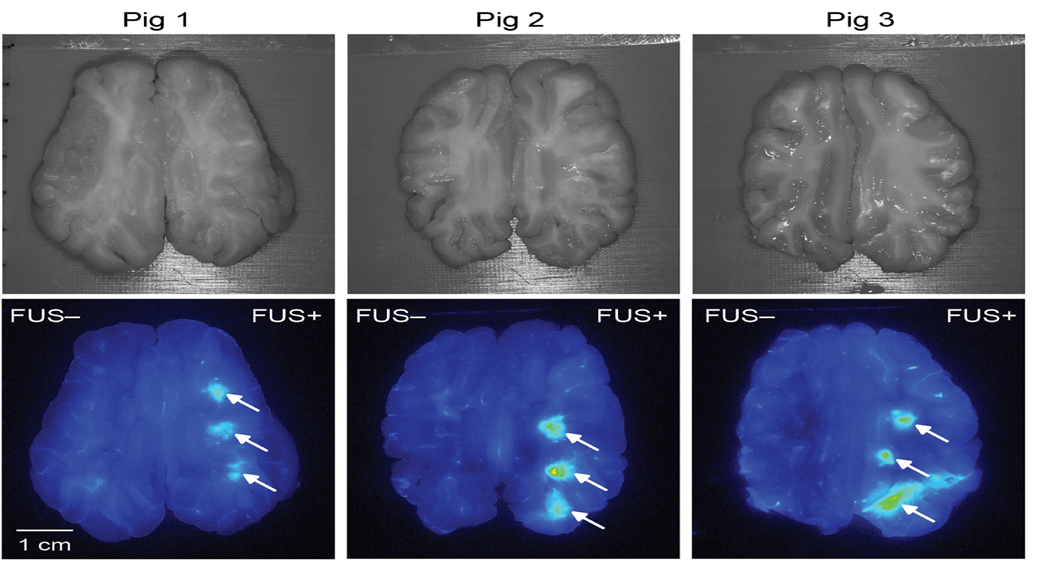Non-invasive technique temporarily opens the blood-brain barrier in animal study
Malignant primary brain tumors are the leading cause of cancer deaths among children and young adults with few therapeutic options. Treatments are limited by the blood-brain barrier, a unique structure within the brain formed by tightly connected cells that line the inside of blood vessels.
The blood-brain barrier blocks harmful toxins, viruses, and other microorganisms from passing through. But it also prohibits anti-cancer drugs, such as immunotherapy, from entering the brain.
An emerging technique
To overcome these limitations, biomedical engineers at Washington University in St. Louis used an emerging technique that combines the application of focused ultrasound (FUS) with intravenously injected microbubbles that amplify and localize the ultrasound’s effects to open the blood-brain barrier. Upon interaction with FUS, the microbubbles exert gentle pressure onto the blood vessels to create a tiny temporary opening that enables drugs to pass through.
Their preclinical study published in Pharmaceutics shows that the combined method facilitated the delivery of an immune checkpoint inhibitor into the brain of a large animal model. A previous preclinical study by a separate research group found that the combined microbubble-FUS method improved the delivery of a different immune checkpoint inhibitor into the brain of a small animal model, which increased the mouse’s survival.
“The study by the Washington University team shows that one of the most promising immunotherapy drugs for treating cancer was delivered safely to the brains of large animals. This delivery method could pave the way for immune checkpoint inhibitors to treat brain cancer in the future,” said Randy King, Ph.D., program director of NIBIB’s Division of Applied Science and Technology.
Evaluation in a large animal model
The researchers used three healthy young pigs for their animal model because pig brains are similar in structure and function to human brains. The procedure involved these steps: microbubbles were administered intravenously; the focused ultrasound was applied to the right side of the brain; and then an immune checkpoint inhibitor, which was labeled with a fluorescent dye, was injected intravenously. The dye is used to track the drug to see if it reaches the target area in the brain.
The first experiment assessed whether the procedure opened the blood-brain barrier in vivo. Using magnetic resonance imaging (MRI) and a contrast agent, the researchers confirmed that the barrier opened temporarily and that the opening increased by 4.8-fold in the regions where ultrasound was applied compared with the regions without ultrasound.
The second experiment was conducted ex vivo to assess whether the immunotherapy drug reached the brain regions where ultrasound was directed. A different type of imaging (fluorescence) showed that the concentration of the immunotherapy drug doubled in areas where ultrasound was applied compared with regions where it was not applied, demonstrating that the drug reached the target area.

Credit: Hong Chen, Ph.D., associate professor at Washington University in St. Louis
“The two experiments showed that the blood-brain barrier opened enough for the therapeutic drug to pass through. Although we didn’t measure how long the barrier was open, ideally it would be a few days to match the half-life of the therapeutic drugs in the blood and to maximize the amount of drugs that can reach the brain,” said senior study author Hong Chen, Ph.D., associate professor at Washington University in St. Louis.
The final two experiments assessed the safety of the procedure. The in vivo MRI and ex vivo tissue analysis revealed that the procedure did not cause significant acute tissue damage.
There were a few study limitations: the pigs used for the experiments were healthy and the study used single-point focused ultrasound in each targeted brain location, which limited the volume of the area it could cover.
The researchers suggested that future studies evaluate drug delivery in a pig model of brain tumors and that large-volume ultrasound be performed, which may deliver the drug more efficiently to the entire brain tumor.
“Now that we know the drug can access brain tissue, we would also like to quantify how much of the drug was delivered into the brain; that will be a critical step if our research moves to clinical trials,” said Chen.
This research was partially supported by grants from NIBIB (R01EB027223, R01EB030102).
This science highlight describes a basic research finding. Basic research increases our understanding of human behavior and biology, which is foundational to advancing new and better ways to prevent, diagnose, and treat disease. Science is an unpredictable and incremental process—each research advance builds on past discoveries, often in unexpected ways. Most clinical advances would not be possible without the knowledge of fundamental basic research.
Study Reference: Siaka Fadera et al. Focused ultrasound-mediated delivery of anti-programmed cell death-ligand 1 antibody to the brain of a porcine model. Pharmaceutics 2023, 15, 2479. https://doi.org/10.3390/pharmaceutics15102479
